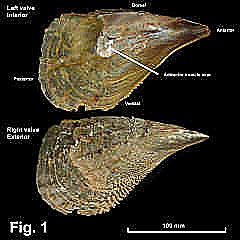|
|
PINNIDAE |
|
|
|
Atrina tasmanica (Tenison-Woods, 1876) Description: Shell moderately fragile, semitranslucent. Shape sharply pointed anteriorly, rounded to subtruncate posteriorly, maximum height at middle of posterior margin. Dorsal margin straight or slightly convex, ventral margin concave at anterior end, then smoothly convex. Shell gaping at dorsal end and at byssal area at anterior-ventral margin. Hinge along anterior half of dorsal margin. Interior with nacreous area extending 2/3 of shell length, not divided by longitudinal groove. Adductor muscle scar within nacreous area, sometimes obscure. Exterior with about 7 radial ribs with open-fronted spines dorsally, and dense lines of smaller spines ventrally. Shell colour green or brown. Size: Up to 350 mm in length, making it the largest species of bivalve in Tasmania. Distribution: Endemic to Australia: Norah Head, NSW, southwards and around southern Australia to Shark Bay, WA, including Tas. Habitat: Subtidal, 2-82 m. Lives embedded vertically in the substrate with posterior end protruding. Common subtidally. Synonymy: Small, strongly scaled specimens from South Australia were named Atrina tasmanica var. dumosa Hedley, 1924. Fig. 1: Trawled in 26 fathoms (48 m) Between Long Reef and Broken Bay, NSW. (DLB2434)
|
|
